Elad Ben Avraham
DocVLM: Make Your VLM an Efficient Reader
Dec 11, 2024



Abstract:Vision-Language Models (VLMs) excel in diverse visual tasks but face challenges in document understanding, which requires fine-grained text processing. While typical visual tasks perform well with low-resolution inputs, reading-intensive applications demand high-resolution, resulting in significant computational overhead. Using OCR-extracted text in VLM prompts partially addresses this issue but underperforms compared to full-resolution counterpart, as it lacks the complete visual context needed for optimal performance. We introduce DocVLM, a method that integrates an OCR-based modality into VLMs to enhance document processing while preserving original weights. Our approach employs an OCR encoder to capture textual content and layout, compressing these into a compact set of learned queries incorporated into the VLM. Comprehensive evaluations across leading VLMs show that DocVLM significantly reduces reliance on high-resolution images for document understanding. In limited-token regimes (448$\times$448), DocVLM with 64 learned queries improves DocVQA results from 56.0% to 86.6% when integrated with InternVL2 and from 84.4% to 91.2% with Qwen2-VL. In LLaVA-OneVision, DocVLM achieves improved results while using 80% less image tokens. The reduced token usage allows processing multiple pages effectively, showing impressive zero-shot results on DUDE and state-of-the-art performance on MP-DocVQA, highlighting DocVLM's potential for applications requiring high-performance and efficiency.
TAP-VL: Text Layout-Aware Pre-training for Enriched Vision-Language Models
Nov 07, 2024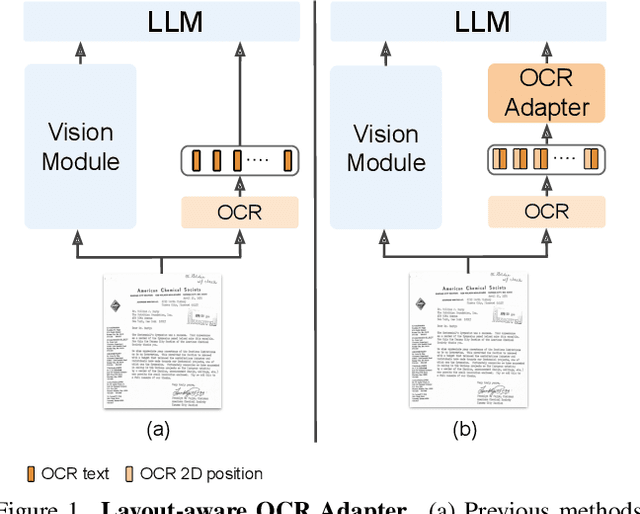
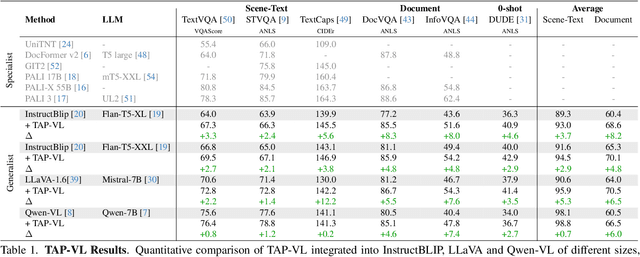
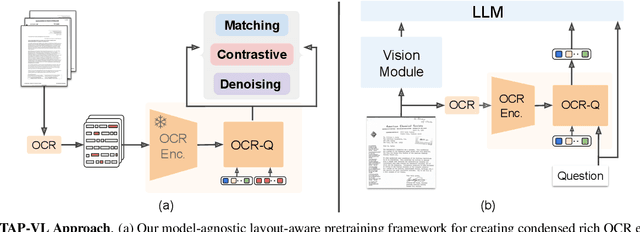
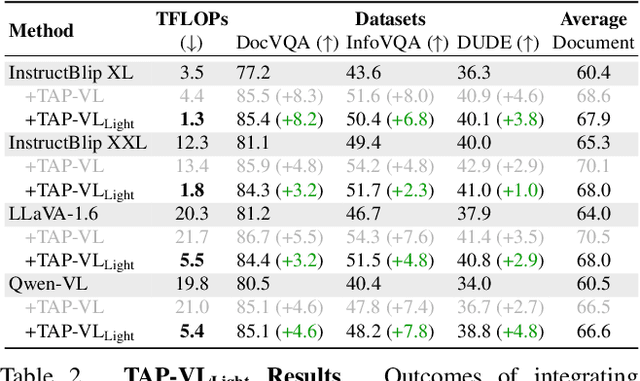
Abstract:Vision-Language (VL) models have garnered considerable research interest; however, they still face challenges in effectively handling text within images. To address this limitation, researchers have developed two approaches. The first method involves utilizing external Optical Character Recognition (OCR) tools to extract textual information from images, which is then prepended to other textual inputs. The second strategy focuses on employing extremely high-resolution images to improve text recognition capabilities. In this paper, we focus on enhancing the first strategy by introducing a novel method, named TAP-VL, which treats OCR information as a distinct modality and seamlessly integrates it into any VL model. TAP-VL employs a lightweight transformer-based OCR module to receive OCR with layout information, compressing it into a short fixed-length sequence for input into the LLM. Initially, we conduct model-agnostic pretraining of the OCR module on unlabeled documents, followed by its integration into any VL architecture through brief fine-tuning. Extensive experiments demonstrate consistent performance improvements when applying TAP-VL to top-performing VL models, across scene-text and document-based VL benchmarks.
Question Aware Vision Transformer for Multimodal Reasoning
Feb 08, 2024


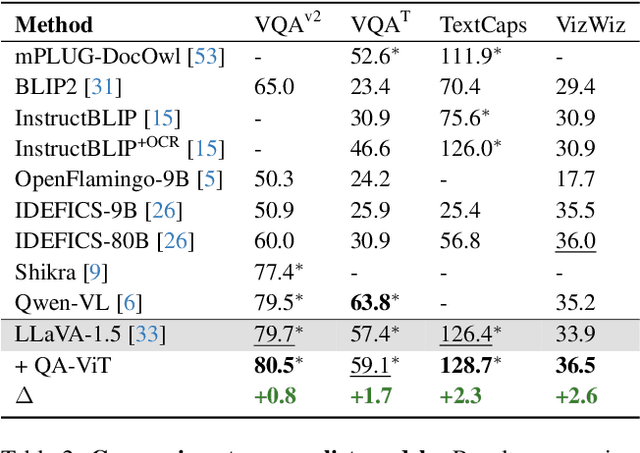
Abstract:Vision-Language (VL) models have gained significant research focus, enabling remarkable advances in multimodal reasoning. These architectures typically comprise a vision encoder, a Large Language Model (LLM), and a projection module that aligns visual features with the LLM's representation space. Despite their success, a critical limitation persists: the vision encoding process remains decoupled from user queries, often in the form of image-related questions. Consequently, the resulting visual features may not be optimally attuned to the query-specific elements of the image. To address this, we introduce QA-ViT, a Question Aware Vision Transformer approach for multimodal reasoning, which embeds question awareness directly within the vision encoder. This integration results in dynamic visual features focusing on relevant image aspects to the posed question. QA-ViT is model-agnostic and can be incorporated efficiently into any VL architecture. Extensive experiments demonstrate the effectiveness of applying our method to various multimodal architectures, leading to consistent improvement across diverse tasks and showcasing its potential for enhancing visual and scene-text understanding.
GRAM: Global Reasoning for Multi-Page VQA
Jan 07, 2024



Abstract:The increasing use of transformer-based large language models brings forward the challenge of processing long sequences. In document visual question answering (DocVQA), leading methods focus on the single-page setting, while documents can span hundreds of pages. We present GRAM, a method that seamlessly extends pre-trained single-page models to the multi-page setting, without requiring computationally-heavy pretraining. To do so, we leverage a single-page encoder for local page-level understanding, and enhance it with document-level designated layers and learnable tokens, facilitating the flow of information across pages for global reasoning. To enforce our model to utilize the newly introduced document-level tokens, we propose a tailored bias adaptation method. For additional computational savings during decoding, we introduce an optional compression stage using our C-Former model, which reduces the encoded sequence length, thereby allowing a tradeoff between quality and latency. Extensive experiments showcase GRAM's state-of-the-art performance on the benchmarks for multi-page DocVQA, demonstrating the effectiveness of our approach.
 Add to Chrome
Add to Chrome Add to Firefox
Add to Firefox Add to Edge
Add to Edge